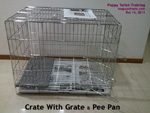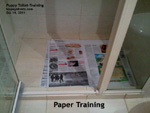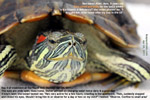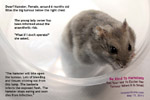I would like to seek your advise with regards to paper training. Three pictures are attached for your reference; a picture of the cage he sleeps in, the toilet area with newspaper, and a view of his cage from the toilet.
I have a 3 month old male miniature poodle whom I brought home about a week ago from a pet shop. We bought him a cage and are in the process of training him to eliminate in the toilet on the newspaper. At the pet shop, he would eliminate about 15 minutes after his meal. However, he eliminates only after a few hours. For example, we will give him dinner at 7.30PM and most of the time he will not eliminate until the next morning. It is rare that he will eliminate within 2 hours. When we spot signs that he wants to eliminate when he is outside the cage, we will bring him to the toilet and coax him to eliminate, whether big or small ‘business’. Most of the time he will not do it unless he has not gone into his cage for a very long time, say a few hours. There are times when he will run to the toilet and smell the newspapers, only to run out, which we take as a hint that he wants to eliminate and put him into the toilet telling him to pee, using the same word every time. Rewards given when he does the right thing.
When we put him into the cage, he will eliminate within a few minutes or even seconds when we are not looking, and that is after we have just brought him to the toilet. The areas which he eliminates in the cage are not consistent. Even if he does not intend to eliminate, he will turn in circles and give us false alarms, as I believe he knows we will bring him out when he does that. We tried washing his entire cage with antiseptic but he still does it inside the cage. The newspapers in the toilet have traces of his pee and also a kind of liquid we bought from the pet shop to help him recognise the place.
For the first two or three days, he used to pee all over the place but after scolding him a few times and cleaning with vinegar, he has not done it since. A crate didn’t help as he peed inside it.
Are we doing something wrong? Some expressed their opinion that a pee tray would be better and the distance between the toilet and cage is too far for him, making him confused. He has not had his third vaccination so we have yet to bring him out.
Thank you very much for taking time to read this email, and also for your informative articles. Looking forward to hear from you soon!
Best regards,
Name of owner
E-MAIL REPLY FROM DR SING DATED OCT 14, 2011
Thank you for your detailed e-mail and the 3
images. As every puppy and owner is different in
personality and training experience, the
following reply may or may not be useful to you.
1. You have confused the puppy in attempting to
grate-train (using the cage) and paper-train him
(inside the toilet) at the same time. Puppies,
like babies, are creatures of routine. One
method of toilet training is needed. Either
grate-training or paper training.
2. At the pet shop, the puppy has had been
trained to eliminate in the grate (floor of the
crate or cage). This type of grate+pee pan
housing is prevalent in the Singapore pet shops
as shown in the image you posted to me. The
puppy wanted to eliminate on the grate but you
wanted him to do on the paper and most likely
paid extra attention and fuss. So, the puppy was
not free to eliminate in privacy after eating as
in the pet shop.
3. To make a long story short, I would propose
just write about paper training as I presume
this is what you want to achieve instead of
writing about grate+pee pan training or both
methods. The grate+pee pan method involves
buying the grate + pee pan separately or the use
of your existing crate.
PAPER TRAINING
3.1 You confine the puppy inside the toilet.
Install a baby-gate. Cover the toilet floor 100%
with paper. At one corner (e.g. left half,
back), away from the baby gate, put a piece of
paper with the puppy's urine or tissue paper
with his urine smell. At the other corner (e.g.
right half, front), his food and water. In the
right half, place his towel, bed, or floor mat,
for example. This will be his clean area.
3.2 The puppy is left there for the next 2 - 4
weeks and given privacy, not stressed out by
your scoldings or presence or the presence of
children and family members during eating for at
least 1 hour.
3.3 The puppy can be taken out to play after he
has pooped regularly and this may take a week.
This is where you observe signs of elimination
(squatting, turning) and put him quickly back to
his toilet.
3.4 Change soiled papers frequently.
3.5 Within 7 days, you should see that the
papered corner where the puppy pees and poops
will be. Reduce the paper area.
3.6 If the puppy shreds the paper, you still
need to persevere and do not scold or shout at
him.
In conclusion, confinement for the first 2-4
weeks is the key to success in toilet training.
What you do during the confinement will require
your perseverance, hard work of keeping the
puppy's "den" (toilet) clean.
The training is much more than what I write. The
devil is in the execution. Pl let me know when
you have succeeded or if you have more queries.
Best wishes.
 TOA
PAYOH VETS
TOA
PAYOH VETS







